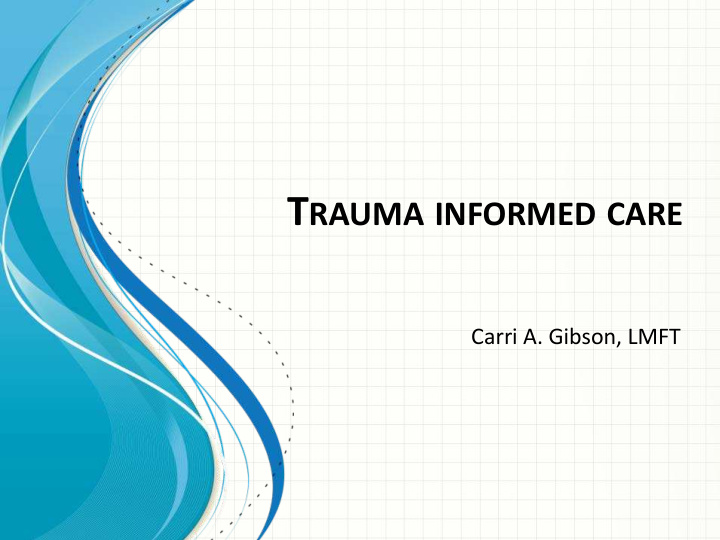



T RAUMA INFORMED CARE Carri A. Gibson, LMFT
Today’s Overview 1 • Definition of Trauma 2 • How does it affect our clients? • TIC and the Five Guiding 3 Principles 4 • Vicarious Trauma 5 • Parking Lot (As Time Allows)
T RAUMA
Definition of Trauma • Emotionally painful Trauma experience that overwhelms Complex • Multiple traumatic instances Trauma
H OW DOES C OMPLEX TRAUMA AFFECT OUR CLIENTS ?
Emotion • Hyperarousal Dysregulation • Survival all the time Resistant • Fear of unknown Dissociation • Out of Body Self-medication • Drugs, Alcohol Decision Making • No trust for anyone including self Process Affected
Hyperarousal • Always on Alert • Difficult to maintain relationships Attachment • Continuing cycle Poor physical • Improper Brain Development and mental • Impaired cognitive and social skills health
Video- Long Term Effects of Domestic Violence
T RAUMA INFORMED CARE (TIC) Realize Realize Trauma Recognize Respond
What is Trauma Informed Care (TIC) • Trauma Informed Care is an organizational structure and treatment framework that involves understanding, recognizing, and responding to the effects of all types of trauma . (traumainformedcareproject.org) • Realize, Recognize, Respond • “What’s Wrong With You?” • “What Happened To You?”
The Five Guiding Principles of TIC • SAFETY • TRUSTWORTHINESS AND TRANSPARENCY • CHOICES • COLLABORATION • EMPOWERMENT
Safety • Ensuring physical and emotional safety • Ask the client • Safety plan • Never, Ever Assume/Non-judgmental
Trustworthiness • Maximizing trustworthiness/Making tasks clear • No collaboration-No trust • Maintaining appropriate boundaries
Choice • Prioritizing consumer choice and control • Respect their voice • They are the expert
Collaboration • Maximizing collaboration and sharing of power with clients • Respect within the work space • We should ask… – Are choices respected? Given consideration? – Honest respect and understanding?
Empowerment • Prioritizing consumer empowerment and skill-building • Validate, normalize and educate – They are right to feel their emotions – Psychoeducation a must!!! • Normalizes reactions • Honor their survival
Culture-Has become the 6 th guiding principle • Acknowledge , respect and integrate cultural values, beliefs and practices within care • Ask questions – Ask about their culture. • Never assume
V ICARIOUS TRAUMA
What Is Vicarious Trauma • Helpers trauma reactions resulting from exposure to clients' traumatic experiences • Cumulative • Not burnout
Symptoms of Vicarious Trauma • Irritability, Poor Sleep, Misuse of Alcohol, Over or Under eating • Headaches, Bowel/Digestion Problems, Lowered Immunity • Loss of interest, Poor relationships, Questioning their identity/world view/spirituality
Strategies to Prevent or Negate Vicarious Trauma • Self-Care – Exercise- Find what works for you – Breathing Exercises – Debriefing/Supervision – Self-knowledge – Nutrition
“Rest and self-care are so important. When you take time to replenish your spirit, it allows you to serve others from the overflow. You cannot serve from an empty vessel.” -Eleanor Brownn
Strategies to Prevent or Negate Vicarious Trauma • Boundaries – Ensure this is about the client – Maintain established conventions – Leave the work at work – Ask questions to examine boundary issues
Summary • Think Trauma First – Is this behavior related to violence and abuse? • Support the Client and Be the Example – This will help to keep with guiding principles of TIC • Maintain Self-Care – This allows you to continue to help and be healthy
Q UESTIONS ?
Recommend
More recommend